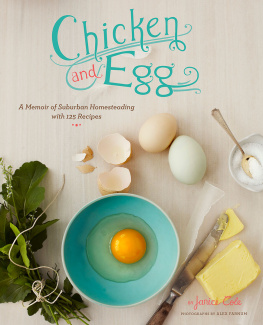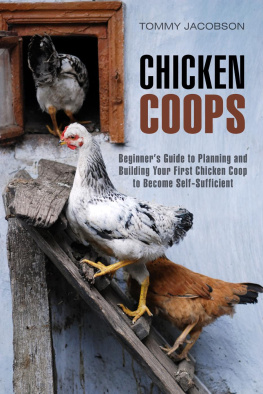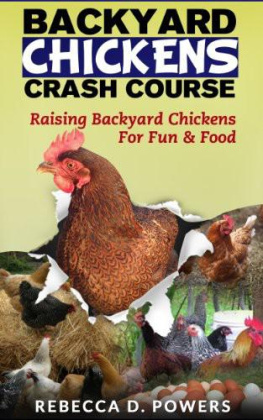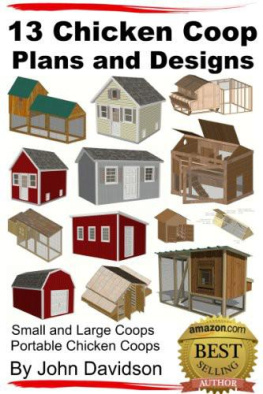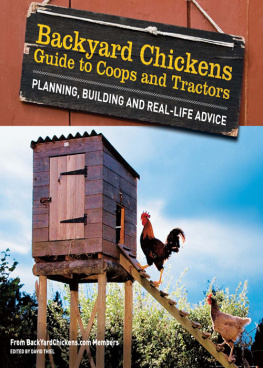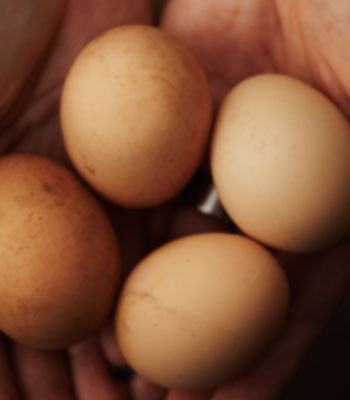To Marty, without whom this book could never have happened.

Theres something about chickens. Their very image seems to produce a chuckle. Just mention that you have chickens or that you want them, and youll be descended upon by someone wanting to know more. Chickens generate a response from everyone, from those who want a flock and need the specifics to those who think youre crazy.
My interest in chickens started over nine years ago. When I finally got a tiny backyard flock, five years later, it immediately proved to be as interesting and fun as I hoped it would be. Today my hens continue to influence me and inspire my cooking.
This book is meant to encourage younot necessarily to raise your own chickens, unless thats your particular passionto appreciate these birds and what they offer us. My hope is that as you begin to understand this species, you will consider the impact you can make when shopping for food and base your choices on how well the chickens are treated, whether theyre raised for eggs, meat, or companionship.
The recipes in this book reflect the bounty provided by the entire chicken. I have therefore included recipes for meat as well as eggs. You may eat chicken or not, depending on your own personal food philosophy. This book is not about influencing this type of food choice.
The chapters are arranged seasonally because chickens are seasonal in their behavior. In the fall and winter, the number of eggs that chickens produce decreases, sometimes so dramatically that they dont lay at all for days or even weeks at a time. As a result, each egg is more precious, and were more careful about how many we use. In the spring and summer, the increased daylight stimulates the chickens to produce lots of eggs, which we use with abandon.
How we cook the meat also changes by season. In the spring and summer, grilled chicken appears on our table along with salads and light sauts, while in the winter we long for soups, roasts, and hearty braises. The recipes showcase the vibrant flavors these birds can provide.
Ingredients
Eggs
All of the recipes in this book are based on large eggs. The U.S. Department of Agriculture (USDA) standard for a large egg in the shell is 2 ounces in weight. A large egg white measures 2 tablespoons, and the yolk measures 1 tablespoon, for a total of 3 tablespoons per large egg. That said, in a carton of eggs you will find some slightly larger and others slightly smaller because it is the total weight of a dozen eggs that determines the size.
| SIZE OF EGG | OUNCES PER DOZEN | OUNCES PER EGG |
|---|
| Jumbo | 30 | 2 1/2 |
| Extra-large | 27 | 2 1/4 |
| Large | 24 | 2 |
| Medium | 21 | 1 3/4 |
| Small | 18 | 1 1/2 |
Obviously, backyard hens produce eggs of varying sizes. When using your own eggs, especially for baking, weigh or measure the eggs before using.
Chicken
If asked whats for dinner, a majority of families across the United States would answer chicken. The amount of chicken Americans consume has more than doubled since 1970. But as processors have scrambled to keep up with the demand, the quality and taste of our chicken has declined. I hope this book will encourage you to search out well-raised chicken and prepare it creatively.
Whether whole or in pieces, chickens vary in size, especially if you buy pasture-raised or free-range hens. Most recipes indicate a range of cooking times, along with a doneness cue. You may need to adjust the time, based on the size of your bird. Its important to not overcook chicken, regardless of what type you buy. But be sure its cooked throughthe temperature at the thickest part of the meat should be at least 165F.
The USDA has defined the following categories of chicken:
Broiler/fryer: A young chicken, about 7 weeks old, weighing between 2 1/2 and 4 1/4 pounds. The majority of chickens sold are in this category. The recipes in this book all work with this category of chicken.
Roaster: An older chicken, about 3 to 5 months, weighing 5 to 7 pounds. Roasters have a generous amount of meat.
Capon: A 4- to 8-month-old castrated rooster weighing about 4 to 7 pounds, with plump, moist flesh.
Stewing hen: A mature hen over 10 months old. The meat is less tender and requires slow moist-heat cooking, such as stewing or braising. It is almost impossible to find a stewing hen in a supermarket, but you may be able to find one at a farmers market or an ethnic grocery store.
When youre shopping for chickens and eggs, labels can be confusing. Heres a guide to help you through the maze:
Cage free: This USDA designation means the chickens have been raised without cages, and it usually means they can walk, spread their wings, scratch the ground, and nest. It does not mean they have any access to the outdoors.
Free range: This term, also regulated by the USDA, means the chicken has access to the outdoors, but there are no requirements on how much time is spent outside or what the conditions are.
Humane: This label is not covered by the USDA, but there are groups, such as Humane Farm Animal Care, that offer certified programs for chickens raised under humane conditions. They usually require that the birds be cage free, with more space than traditional facilities provide, and have access to the outdoors. They prohibit forced molting (to control laying), and require a natural diet with no animal by-products.
Natural: This term is meaningless because it is not regulated. All chickens are considered natural because they are not a processed food. However, even chickens labeled natural may contain natural additives such as seaweed extract (carageenan).
No hormones or antibiotics added: The USDA has ruled that no hormones can be given to chickens. It also forbids the routine use of antibiotics, but they may be given to treat ill chickens.
Organic: Chickens and eggs with an organic label, which is regulated by the USDA, are kept cage free, with access to the outdoors. They cannot be given antibiotics, and their food must meet organic standards.
Pasture raised: There are no USDA regulations for this term, but it usually implies the hens were allowed to forage on pasture and eat a natural diet of greens and bugs, supplemented by feed. I find these to be the best-tasting eggs and chicken, and studies have found them to be the most nutritious. You can purchase them at your local farmers market or food co-op.
Vegetarian fed (or grain fed): Labels with these unregulated terms mean just what they say. Even though chickens are not natural vegetarians, vegetarian fed has gained widespread acceptance because it indicates the chickens were not given any feed containing chicken feathers, other chicken by-products, or pork or beef (unscrupulous, but not unheard-of practices).
Equipment
Pots and Pans
Good-quality cookware almost always makes a cooks job easier. I prefer pots and pans with a heavy core of aluminum on the bottom and sides, lined with a thin layer of stainless steel. That said, all of the recipes in this book will work well with whatever cookware you have in your kitchen, but lightweight pots and pans may require a little more vigilance.

